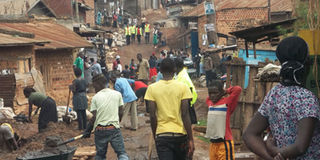8.4% of Ugandans slip back into poverty

Serious analysis. According to Ubos, there is need to engage a serious analysis to understand why many Ugandans are slipping back into poverty. FILE PHOTO
The Uganda National Panel Survey released yesterday indicates that 8.4 per cent, which represents 338,520 of the about 40.3 million Ugandans have slipped into poverty in the 2018/19 financial year.
The findings released by Uganda Bureau of Statistics (Ubos) yesterday also indicate that 4.5 per cent of Ugandans in urban areas have slipped back into poverty compared to 10.4 per cent in rural areas. This according to Ubos requires a deeper analysis to understand why many Ugandans are slipping back into poverty.
Presenting the findings in Kampala yesterday, Mr Danstan Aguta, a senior statisticians as Ubos, said that at the national level 8.5 per cent of Ugandans are chronically poor.
At 21.6 per cent, northern Uganda, a region that is struggling to recover from 20 years of war, has the biggest share of chronically poor Uganda followed by eastern and western Uganda which have a share of 10.7 per cent and 4.9 per cent respectively.
The findings also indicate that 16.6 per cent of Ugandans in northern Uganda slipped into poverty while 14.3 per cent moved in the same direction in Eastern Uganda.
At least 7.5 per cent of Ugandans in western compared to 4.7 per cent in central, slipped back into poverty.
Mr Aguta said the findings covering the 2018/19 financial year is the seventh in a series of Panel Household Surveys that used the 2005/06 Uganda National Household Survey as the baseline.
“The [Uganda National Panel Survey] is a multi-topic household survey that is undertaken annually over a twelve – month period. The UNPS produces annual estimates of incomes in key policy areas as well as providing a platform for the experimentation and assessment of national policies and programmes,” he said.
The overall objective of the Uganda National Panel Survey is to collect high quality data on key indicators such as poverty, service delivery and employment among others in order to monitor government and other development frameworks.
In terms of expenditure, according to the findings, Ugandans spend 41.5 per cent of their income on food, 3.7 per cent on health, 6.2 per cent on transport, 19.4 per cent on housing, water, electricity gas, and fuels while 2.5 per cent is spent on clothing and footwear.
The findings also indicate that 52 per cent of Ugandans remain engaged in agriculture while 22 per are in non-agricultural activities. At least 26 per cent have moved in or out of agriculture.
At least 13 per cent of those who have completed post-secondary education (tertiary) have remained in agriculture while 21 per cent have moved out.
Twenty three per cent of those that have completed secondary education remained in agriculture while 31 per cent have moved out.
At least 75 per cent of Ugandans without formal education remain in agriculture while only 19 per cent have moved out.
Ms Imelda Atai Musana, the Ubos deputy executive director, said poverty dynamics in Uganda are measured on the basis of those who can afford three meals day and less on less than $1 a day.
“Poverty dynamics in Uganda remain very complicated to understand. There is need for further investigation and analysis to understand poverty dynamics,” she said.
International poverty movements
The recently released Sustainable Development Goals 2019 report paints a mixed picture of global progress on extreme poverty eradication.
On the one hand, global poverty rates, measured as the proportion of people living below the $1.90 a day international poverty line, have continued to decline.
In 2018, an estimated 8.6 per cent of the world’s population was living in extreme poverty, down from about 28 per cent in 2000 and 16 per cent in 2010.
On the one hand, global poverty rates, measured as the proportion of people living below the $1.90 a day, have continued to decline.
In 2018, an estimated 8.6 per cent of the world’s population was living in extreme poverty, down from about 28 per cent in 2000 and 16 per cent in 2010.
In sub-Saharan Africa, more than 40 per cent of the population are still living on less than $1.90 a day and the total number of extremely poor people is significantly higher today than it was two decades ago.
Worryingly, the pace of progress in eradicating poverty has notably slowed in recent years.




